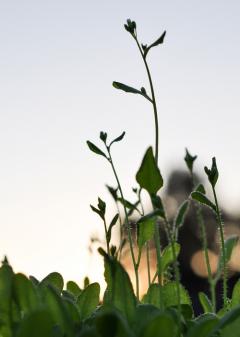Outdoor study lends insight into flower timing
Research on plants grown outdoors has revealed new activity of a key gene that controls when flowers appear.
The results indicate that lab conditions, used by plant scientists worldwide, need to be altered to better match outdoor conditions to gain a more realistic understanding of plant behaviour.

The study identified a burst of activity in a gene linked to flowering – known as FT – in the morning as well as in the evening.
Previous studies conducted on plants grown in lab conditions had shown that the FT gene was active only in the evening.
The findings give valuable insight into the biological mechanisms that cause plants to allocate resources to producing flowers – and grains, nuts and fruits – in springtime.
Comparing growth
An international team of researchers, including Edinburgh scientists, made their findings using Arabidopsis, a cress plant that is widely studied for understanding plant behaviour.
Researchers at the University of Washington in Seattle, who led the study, came up with the experiment because conditions at the summer solstice in the city are similar to the standard lab growing conditions for Arabidopsis – 16 hours of light and eight hours of darkness.
Growing plants outdoors in conditions similar to those in the lab allowed scientists to check whether what they had seen in the lab reflected what happens in nature.
Outdoor plants produced fewer leaves than indoor plants, indicating that the outdoor plants flowered earlier.
Both outdoor and indoor plants showed evening peaks of activity in the FT gene, but outdoor plants also showed a morning peak of FT activity.
Different Conditions
Scientists concluded that the lab conditions missed key qualities of natural conditions, affecting the expression of the FT gene and its ability to trigger floral growth.
Researchers were able to recreate outdoor results in the lab plants by altering the colour of artificial light and by modifying temperatures to mimic the cool dawn outdoors.
The study, involving teams in Switzerland, South Korea and Japan, was published in Nature Plants.
If we can more accurately reflect natural conditions in our experiments, this will lead to detailed understanding of realistic plant behaviour – which could be important for studying the biosphere response to climate change or developing sustainable supplies of crops.
Related Links
Molecular basis of flowering under natural long-day conditions in Arabidopsis, Nature Plants

